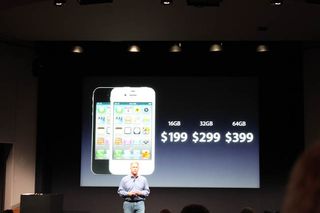iPhone 4S on Sale Oct 14th: A5 Processor, 8-MP Camera, Ground-Breaking Siri Assistant

The iPhone 4S is coming October 14th to AT&T, Verizon, and Sprint, and although it looks the same as the previous version, it has serious power under the hood. Epic games demonstrated "eye-melting" graphics on the new Infinity Blade 2, a follow-up to one of the best mobile games ever. This is made possible by the new A5 processor. What else does the iPhone 4S have going for it? Apple claims that the iPhone 4S is just as fast as competing 4G phones when it comes to data performance, thanks to a new antenna system and other improvements (we'll have to see about that). The device also sports a new 8-MP camera that's not only sharper but much faster than its predecessor. It can record 1080p video, complete with image stabilization.
The most impressive feature of the iPhone 4S is Siri, a voice-controlled assistant that lets you do all sorts of things just by speaking. You can ask for the weather, search the web and Wikipedia, schedule meetings, and more. Siri calls itself a humble personal assistant, but it is pretty amazing because it's conversational and understands context. The iPhone 4S will start at $199 at come in 16GB, 32GB, and 64GB versions.
Here are the big highlights of the iPhone 4S as well as a gallery of images taken at today's event.
iPhone 4S Features:
A5 Processor
- A5 processor with 2X the performance and 7X the graphics performance
- 8 hours of talk time on 3G, 9 hours of Wi-Fi Browsing, so the A5 CPU offers more efficiency
New Antenna System
- New antenna system: Can intelligently switch between two antennas for transmit and receive
- Can download data 2X as fast as before, capable of 14.4 Mbps down
- The iPhone 4S is a world phone, so it works on GSM and CDMA networks
Camera
Stay in the know with Laptop Mag
Get our in-depth reviews, helpful tips, great deals, and the biggest news stories delivered to your inbox.
- 8-MP camera (3264 x 2448) with backside illumination that gathers 73 percent more light than previous
- The camera also captures pics 33 percent faster. A new Hybrid IR filter for better color accuracy
- There's a five element lens with 30 percent more sharpness and f/2.4 aperture, which means you can let in more light
- Inside the A5 is an advanced image processor, which helps with face detection
- 1.1 seconds to get the first picture, and even faster after that
AirPlay Mirroring
- If you have an Apple TV, you can stream whatever is on your phone straight to your big screen, including games, movies, videos, and other content.
Siri
- Apple is leveraging its acquisition of Siri inside the iPhone 4S. You can get to it at any time by pressing and holding the home button.
- You can ask something like what's the weather in Cupertino today. You can also ask the hourly forecast.
- Siri can even answer more conceptual questions, like "Should I take an umbrella today?"
- The app is also integrated into the clock, so you can ask what time it is in Paris, or you can set an alarm by saying "Wake me up tomorrow at 6 a.m."
- Because Siri integrates with Yelp, you can say "Show me Greek restaurants nearby."
- Siri integrates with maps for directions as well, but we didn't see free turn-by-turn directions.
- You can ask Siri to read messages to you hands-free: "Read my message" You can also ask Siri about your calendar: "Do I have any meetings this Friday at noon?" Then you can reply. Pretty brilliant stuff.
- Siri is scary smart. You can say "Schedule a meeting with Phil at noon on Friday." Siri also integrates with reminders.
- Siri works with web searches via Wikipedia and Wolfram Alpha for answers to all sorts of questions. This includes exchange rates. "How many dollars is 45 euros" is answered almost immediately.
- Anywhere you see a keyboard you can use Siri for dictation.

